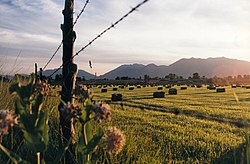Utah County | |
|---|---|
 Historic Utah County Courthouse | |
 Location within the U.S. state of Utah | |
 Utah's location within the U.S. | |
| Coordinates: 40°07′N111°40′W / 40.12°N 111.67°W | |
| Country | |
| State | |
| Founded | January 31, 1850 (created) April 18, 1852 (organized) |
| Named after | Ute Tribe |
| Seat | Provo |
| Largest city | Provo |
| Area | |
• Total | 2,144 sq mi (5,550 km2) |
| • Land | 2,003 sq mi (5,190 km2) |
| • Water | 141 sq mi (370 km2) 6.6% |
| Population (2020) | |
• Total | 659,399 |
• Estimate (2024) | 747,234 |
| • Density | 310/sq mi (120/km2) |
| Time zone | UTC−7 (Mountain) |
| • Summer (DST) | UTC−6 (MDT) |
| Congressional districts | 3rd, 4th |
| Website | www |
Utah County is the second-most populous county in the U.S. state of Utah. The county seat and largest city is Provo, [1] which is the state's fourth-largest city, and the largest outside of Salt Lake County. As of the 2020 United States census, the population was 659,399. [2]
Contents
- History
- Geography
- Major highways
- Protected areas
- Lakes
- Demographics
- 2020 census
- Ancestry
- Religion
- Government
- Politics
- Social issues
- Infrastructure
- Education
- School districts
- Colleges and universities
- Communities
- Cities
- Towns
- Census-designated places
- Unincorporated communities
- Former communities
- See also
- References
- Further reading
- External links
Utah County is one of two counties forming the Provo-Orem metropolitan area, and is part of the larger Salt Lake City metropolitan area. In 2020, the center of population of Utah was in Utah County, in the city of Saratoga Springs. [3]
Utah County is one of the fastest-growing counties in the United States, ranking among the top ten counties in numerical growth. [4] Correspondingly, Provo–Orem is among the top eight metropolitan areas by percentage growth in the country. [5]
Utah County is one of seven counties in the United States to have the same name as its state. The other six counties are Arkansas County, Hawaii County, Idaho County, Iowa County, Oklahoma County and New York County (commonly known as Manhattan). [6]






